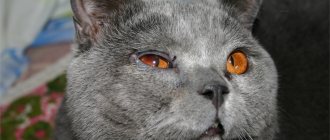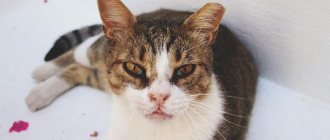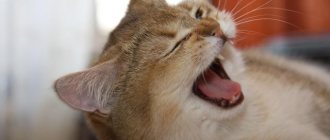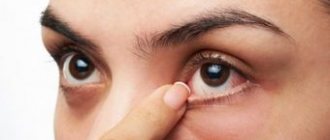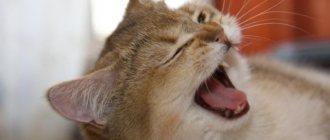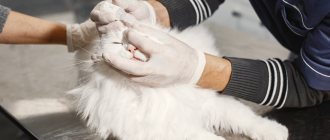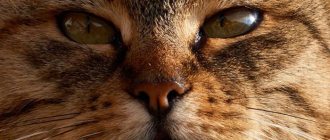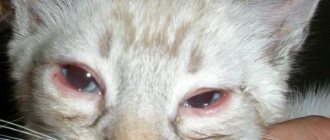Are watery eyes a breed trait?
You can often hear the following phrase from veterinarians and pseudo-experts regarding lacrimation in the British: “What do you want? This is such a breed, their eyes are always streaming.” There is some truth in this, but only partly. Let's figure out why British cats actually have watery eyes.
Representatives of the British breed are brachycephalic, i.e. cats with a spherical head shape, including due to the fact that they have a shortened muzzle. Compare the skull of a brachycephalic and a non-brachycephalic.
The spherical head is a breed standard, giving it a special charm, but with it the British received an atypical anatomical structure of the nasolacrimal ducts. Brachycephalic cats and dogs have some curvature and deformation of the nasolacrimal ducts, which, when severe, makes it difficult for tears to flow into the nasopharynx.
Despite this, normally a British cat should not have constant lacrimation. Most representatives of the breed have healthy eyes, because breeding cats and female cats are selected not only for beauty, but also for health. We are, of course, talking about animals from officially operating nurseries according to all the rules. You can expect anything from the British, bought second-hand.
If there is a problem with lacrimation, this means that:
- the breeder did a poor job and was unable to maintain in his graduates the structure of the nasolacrimal duct that allows normal functioning;
- or the cause of lacrimation is not anatomical features at all.
Also, it often seems to the owner that the condition of the eyes is unhealthy, but, in fact, everything is in order. Below we will teach you how to distinguish normal from pathology.
Additional symptoms
If the problem is not related to allergies, then the pet may have noticeable redness of the conjunctiva.
When a British cat's eyes become watery due to the influence of an allergen or irritant, no additional symptoms may be recorded. In this case, no special treatment is required and the problem goes away on its own after the irritant is eliminated. When pathological factors become the source of increased tearing, the Briton may develop a fever and experience other clinical signs:
- swelling in the area of the visual organs;
- purulent or mucous discharge;
- brown or red crust in the corner of the eye;
- itchy sensations;
- swelling of the conjunctival membrane and its redness;
- fear of bright light.
With prolonged tearing, Britons often experience hair loss around the eyes, which soon leads to sores and dermatitis.
Normal and pathological - how to distinguish?
Many owners notice brown crusts in the corners of their cats' eyes after sleeping. This is the norm. When released, the tear is transparent and does not have any impurities. The liquid then lingers on the fur and oxidizes in the air, resulting in the feeling that your British cat's eyes are watering brown. In fact, brown crusts (sometimes they have a reddish tint) are just dried, oxidized tears. It looks like this.
Pathology is observed when:
Article continues after advertisement
- tears flow constantly, even while awake, there are a lot of tears, as if a cat is crying (scientifically the phenomenon is called epiphora);
- the tear is cloudy, whitish, greenish or yellowish;
- in addition to the tears, it is clear that the eyelids and conjunctiva are inflamed;
- hair falls out around the eye;
- blepharospasm (the cat squints its eye).
Medicines
You can treat a kitten with folk remedies, but they are not always effective. Therefore, if you have not noticed a visible effect after a course of rinsing, try some proven medications.
- At night, tetracycline ointment is placed behind the kittens' eyelids.
- Lightly dissolve potassium permanganate or furatsilin in water and use for rinsing.
- The product "Iris" contains chloramphenicol, so it perfectly fights irritation and allergies.
- “Diamond Eyes” is an excellent remedy for treating watery eyes in a kitten based on taurine and succinic acid. Helps combat mucous membrane irritation in animals.
- If your cat’s eyes are watery, herbal-based “Phytoelita” lotion can be substituted.
Source
The real reasons why a British cat has watery eyes
As you already understand, slight leakage of tears in the form of clear and brown discharge is not necessarily a pathology. But normally there should not be a large amount of discharge. The tear should go into the nasolacrimal duct and not pour out. The first reason why it spills out is because there is too much liquid being produced. The second reason is the incorrect anatomical structure. Below we list the main causes of a large amount of discharge, as well as the causes of pathological purulent tears and tears accompanied by other symptoms.
The structure of the nasolacrimal duct
In some cats of brachycephalic breeds, as we have already said, the nasolacrimal duct is shortened, curved or narrowed so much that it cannot function normally. And sometimes it is completely absent. Such individuals experience chronic lacrimation, because a tear has only one way out - outside.
This pathology can be easily identified by a competent veterinarian, preferably an ophthalmologist. Bad doctors often don’t even check the canals and, suspecting an infection, immediately prescribe anti-inflammatory and antibacterial drugs. But in this case there is no point in prescribing them, since the problem lies in the anatomical structure, which cannot be avoided by the use of medications. In some cases, the incorrect structure of the nasolacrimal duct can be corrected surgically.
Entropion of the eyelids
Another anatomical cause of increased lacrimation is inversion of the eyelid (entropion). Previously, bloats were common among the British, but now there are few such representatives of the breed, because... breeders carry out competent selection. Again, we are talking about cats purchased from official catteries, and not “from hand”.
Entropion occurs when the fold of the eyelid folds inward and continually irritates the surface of the eye. This leads to increased fluid production. Then inflammation occurs and a bacterial process often joins.
The situation can end sadly, so there is no time to waste - you need to have an operation. In some cases, the veterinarian decides to first do a trial of drug therapy with eyelid massage. If therapy does not help, blepharoplasty is performed.
Trichiasis
Trichiasis is a condition in which cilia grow right along the edge of the eyelid, although a cat's eyelid is normally free of hair. As a result of this deviation, the fur is constantly in contact with the eyeball, irritating it. You can help the animal by cutting the fur, styling the hair in the right direction using special means, as well as by surgery. The third way is preferable.
A separate pathology is identified as ectopic eyelashes. These eyelashes grow from follicles located in or near the meibomian glands. Ectopic eyelashes rub against the cornea, causing irritation, leading to lacrimation and blepharospasm.
There are other pathologies associated with hair growth around the eyes and anatomy. To identify these pathologies, you need to contact an experienced veterinary ophthalmologist.
Dead hair gets into the eye
Sometimes the eyes of a British breed cat run due to the fact that during molting, hair flies onto the cornea. Britons are a heavy shedding breed with a thick undercoat that can cause eye irritation and watery eyes. In this case, the owner, opening the cat’s eye and looking into it in the light, will notice hairs moving freely across the cornea. You don’t need to pull them out with your hands: just rinse your eyes and comb the cat thoroughly. Those. in this case, you need to deal with shedding first, otherwise the fur will constantly attack the eyeballs.
Article continues after advertisement
Worms
Often the cause of discharge from the eyes, especially in small kittens, is helminths. In this case, deworming is indicated if it has not been carried out in the last 3 months. If after deworming for about 1-2 weeks the discharge from the eyes has disappeared, then the cause was intestinal infestation.
Ticks
In rare cases, microscopic demodex mites can cause inflammation of the eyelids and conjunctiva of the eyes in combination with the secretion of tears. Read more about this reason in the article “Eye mites in cats.”
Viruses and bacteria
In most cases, the cause of increased tearing is associated with infections (fungi, viruses and bacteria). Many owners think that if only one eye is affected, then it is not an infection. But, in fact, most infections start in one eye and then spread to the other. Particularly worth highlighting are rhinotracheitis, calicivirosis, mycoplasmosis and chlamydia. These are the most common infections that also affect the eyes.
The most common cause of viral lacrimation is herpesvirus , which causes the disease rhinotracheitis. Its signs are swelling around the eye, the eyelids do not close, and pus is released. In kittens, herpes causes the death of epithelial cells of the eye, which often results in necrosis, scars and adhesions. Scarring can cause the eye to become covered with a film, which subsequently leads to blindness. Therefore, the faster help is provided, the greater the chance of saving the eye. A delay of 1-2 days can already cost a cat a normal eye.
Herpes is often disguised as other diseases, including during laboratory diagnosis. A disease with which the manifestations of herpes can be confused is chlamydia . Visually distinguishing herpes from chlamydia can be difficult. Therefore, you need to know your medical history and do a smear. However, even after this it is not always possible to make the correct diagnosis. An experienced ophthalmologist can begin treatment, despite a negative analysis, if he sees specific manifestations.
Mycoplasmosis is a fungal infection that occurs as a result of the activation of opportunistic microorganisms - mycoplasmas, which live in the eyes of most healthy cats. Mycoplasma is often a secondary infection, such as with herpes. But veterinarians take an analysis of it and, finding that the indicators are exceeded, begin to treat mycoplasma. Although all that happened was that, against the background of the development of another infection, mycoplasma also began to actively multiply. In this case, there is no point in treating them, because... the root cause is different.
It’s sad but true that after suffering infections (often rhinotracheitis), cats sometimes have overgrown lacrimal openings where tears should go. And after herpes, inflammation in the nasolacrimal ducts and their narrowing often develops. Complete blockage of the canals can be observed after herpes, chlamydia, bacterial conjunctivitis and other diseases. It turns out that the body has already defeated the infection, but the tears still flow. In this case, it wouldn’t hurt to check the condition of the lacrimal openings and nasolacrimal duct, which veterinarians often “forget” to do. If the diagnosis is confirmed, the issue is resolved surgically. And if the correct diagnosis is not made, then the cat begins to be healed, which may even help temporarily, but the problem still recurs.
Also, when making a diagnosis, the veterinarian must take into account that there are diseases caused by the combination of several pathogens. Often a viral infection begins first, and then bacteria and fungi join it. You need to understand whether to treat a cat whose eyes are festering for one infection or for several at once. The approach will vary.
The owner should know that many cats are latent carriers of viral infections, and mycoplasma is generally part of the opportunistic microflora. Infectious agents, which in a healthy state are suppressed by the immune system and do not manifest themselves in any way, are often activated when the cat’s immunity declines. If suddenly your pet gets sick, she might not even have contact with another animal. And you, as a caring owner, must draw conclusions for yourself about the decrease in your pet’s immunity and take measures to increase it.
Injury
Mechanical damage can cause discharge and blepharospasm (when the animal squints its eye due to pain). In this case, you first need to make sure that the traumatic object is not in the eye, and then begin to treat the infection (bacteria and fungi) that has attacked the injured membrane. As a rule, in such cases antibiotics are prescribed in the form of drops. Severe injuries may require surgery.
Article continues after advertisement
Allergy
Often, a veterinarian who has not found the cause of lacrimation, instead of diagnosing “idiopathic epiphora” (epiphora of unknown etiology), diagnoses “allergy”. It would be good if before this he examined the animal up and down and came to a clear conclusion that other reasons could not cause the problem and there is an allergen to which a reaction is observed. It’s bad if the diagnosis is made by eye and before that a high-quality history taking and various studies were not carried out. But lately the second option has become increasingly common.
According to experienced ophthalmologists, an allergy in its pure form is not only the leakage of a large amount of clear liquid, it is also severe swelling, as if a bee had stung the eye. An allergy is an acute and severe reaction, and it manifests itself to a specific agent (eating a product, inhaling a certain smell, etc.). In most cases, the owners themselves notice what the reaction is to. Allergies are also possible at certain times of the year to flowering flowers.
Most often, when a doctor, having not found a cause, diagnoses “allergy”, but the cat’s eyes are simply leaking, there is no significant inflammation and no tests have been carried out for the allergen, the cause of the condition is not an allergy at all.
Lighting
Occasionally, cats have a reaction in the form of lacrimation to fluorescent lamps. It’s easy to test this theory: temporarily move the animal into a room with different lighting. If the symptoms go away, then that was the cause.
Dust and tobacco smoke
Cats are very sensitive to different odors and microparticles in the air. Their leakage of tears can be caused by dust, tobacco smoke, air fresheners, etc. This is again calculated experimentally: remove the irritant from the cat’s life and see if there is an improvement.
The cat's eyes runny while eating
Some owners complain that their British kitten or adult cat's eyes water while eating or immediately after. This, on the one hand, may be a sign of an allergy if swelling and redness are observed. But more often this phenomenon is the norm: while absorbing food, the jaw actively works, which provokes the release of tears. Gnawing on large pieces of meat helps clear the nasolacrimal ducts. Therefore, feeding cats raw meat is used to prevent eye problems associated with fluid stagnation.
Preventive measures
In order for an animal not to get sick, it must eat properly. Cat nutrition is the key to their health and longevity. You should not feed your pets from your own table. You should initially accustom your four-legged friend to a certain diet. It should be remembered that food should be without salt and spices.
It is very important to keep the room clean and tidy. Sometimes tearfulness in animals appears as a reaction to dust. To prevent this from happening in the future, you need to do wet cleaning once a week.
The British cannot tolerate drafts or smoke, so it is better not to smoke in a room where there is an animal. Clear eyes indicate the health of the animal, while their cloudiness, as well as tears, indicate some kind of problem. When using eye drops, they should be applied in small quantities to check for an allergic reaction. Only after this can therapy begin.
Did you like the article?
What to do if your eyes are watery?
Most infectious diseases can lead to serious damage to the visual organs. In some cases, for example, with Pseudomonas aeruginosa, the clock is ticking: literally within a day the organ can “burn out.” If you start treatment on time, you can do without complications.
If the process is external and it is just beginning, it can be stopped by simply washing it with clean boiled water or chamomile decoction in order to wash away excess pathogenic microflora. This can be first aid if there is no veterinary clinic nearby.
A veterinarian has many diagnostic and treatment methods at his disposal. It can be carried out with the help of medications if the process is infectious. For example, with an external bacterial process, Floxal ointment works well, but with viral lesions, a completely different therapy is prescribed, because Antibiotics are useless for viruses. If there is a blockage in the nasolacrimal duct, try to rinse it. In some cases, surgery is indicated. In any case, the veterinarian must offer a solution.
It’s better not to mess around with self-diagnosis and treatment. It is the cases where the cat was treated independently that pose the greatest difficulty even for a good veterinarian. Sometimes the owners turn to the doctor, but he can only state that the animal has already become blind as a result of delays in tests and treatment.
Article continues after advertisement
Grown-up individuals
After 6 months of age, any discharge from the animal’s eyes should stop. If the problem does not disappear, it is worth monitoring the pet’s behavior. If a Briton’s eyes are watery for several days, the cat scratches them and squints, we can assume different versions:
- hit by a speck;
- blockage of the tear ducts (the eyes begin to sour);
- mucosal injury;
- allergies to various pathogens;
- helminthic infestations;
- infections – dangerous and not so dangerous.
Before proceeding with treatment of the pathology, the cause of lacrimation should be established.
British eye care
The eyes of a healthy Briton do not require special care. If brown crusts form after sleep, they should be removed using a cotton pad moistened with water or a special cleaning solution. Otherwise, tear tracks may stain the fur.
If the cause of lacrimation is hair constantly getting into the eyes from the face and body, the cat needs to be thoroughly combed, during periods of shedding - every day. It is impossible to comb out small hairs on the face, and therefore they can be plucked with your fingers. Dead hairs are easily plucked out, but there is no need to pull out still living hairs - let them grow.
And one more important point: if a Briton’s eyes are constantly leaking, the owners resort to rinsing. This helps when the cause of lacrimation is hair getting into the eyes, as well as when a bacterial process begins. But you cannot use rinsing with water or herbal decoctions constantly. Even harmless chamomile or tea are liquids hostile to the microflora of the eyes. Without consequences and for a long time, you can only use a saline solution that is close in composition to the natural environment of the body.
Treatment recommendations
The first thing to do is consult a veterinarian. © shutterstock
You can provide first aid yourself:
- Buy an anthelmintic and undergo treatment for parasites.
- Rinse your eyes several times a day with black tea or chamomile infusion.
- Decoctions of St. John's wort, calendula, and sage also help.
During rinsing, you should wash your hands thoroughly ; you can use either cotton wool or cotton pads; while rinsing, pass the cotton from one corner of the eye to the other, changing a piece of cotton after each time.
Prevention of lacrimation
Whatever condition your British cat’s eyes are in now, you need to remember preventive measures.
- Take care of the animal's immunity, because... Often the cause of problems is latent infections and the riot of opportunistic microflora. Maintaining immunity consists primarily of healthy eating, physical activity and a lack of stress.
- Avoid contact between the animal and sick brothers. Many people like to pick up stray cats on the street and immediately bring them home. It is not right. The animal must be examined by a veterinarian followed by quarantine.
- Brush your cat regularly to keep dead hair out of your eyes. If you have already gotten it, you need to rinse your eyes.
- Do not use antibacterial eye drops unnecessarily. The organ can be constantly washed only with saline solution.
- Regularly give your cat raw meat, eating which provokes the secretion of tear fluid and clearing of the nasolacrimal ducts.
- Perform regular routine deworming and, if necessary, preventative or therapeutic treatment against fleas and ticks.
- Try not to use aroma lamps and sticks, aerosol air fresheners at home, and do not smoke.
- If a problem occurs, contact your veterinarian immediately. Do not engage in self-treatment, which blurs the symptoms and leads to relapses, and also makes it difficult for the veterinarian to make a diagnosis.
Rate and share!
Infectious diseases, worms
It is necessary to understand why tears flow from a cat’s eyes in order to exclude infection with helminths and infectious diseases, which not only can lead to the death of the animal, but also pose a danger to humans. Excessive lacrimation is observed with chlamydia, calcivirosis, rhinotracheid, which a person can become infected with from a sick animal.
Severely watery eyes and drooling are also observed when infected with rabies - an incurable disease transmitted from a sick animal to a person through a bite, saliva, or tear fluid getting into wounds, microcracks in the skin. To prevent infection with rabies, vaccinate your cat against rabies and other infectious diseases, and give anthelmintic drugs twice a year.
Symptoms
If a pathological cause is obvious, all manifestations of the disease should be observed to give the doctor as complete a history as possible to ensure the best decision.
Common cat diseases manifest themselves as follows:
| Symptom | Disease and cause |
| Long and profuse tearing. | Viruses and fungi such as plasmosis: calcivirosis, mycoplasmosis, toxoplasmosis, etc. |
| Pus. | Foreign objects. |
| Edema. | Turn of the century. |
| Cloudiness. | Keratitis, cataract. |
| Black spot. | Dying of the cornea. |
| Tears are accompanied by fever, diarrhea, vomiting, and lethargy. | Feline distemper (panleukopenia). |
| Swelling with cloudiness. | Glaucoma. |
| Swelling in the corners of the eye. | Inflammation of the lacrimal glands. |
| Redness of the membranes, photophobia. | Conjunctivitis. |
| Damage to one eye. | Parasites. |
This is interesting: When to castrate a British cat
